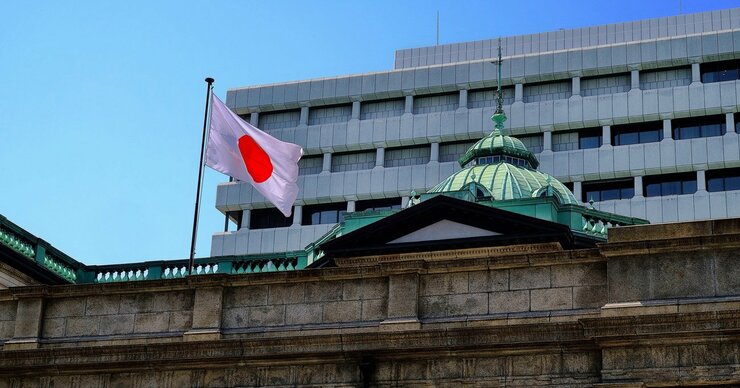Originally published in Japanese on June. 15, 2023
Reviewing 25 unconventional years
Over the past 25 years, the BOJ has implemented various unconventional monetary easing policies, including zero interest rates (1999-2000), quantitative easing (2001-2006), comprehensive monetary easing (2010-2013), qualitative and quantitative monetary easing (April 2013 to present), and yield-curve control (2016 to present). The BOJ has also already experienced two exits: one from zero interest rates in 2000 and another from quantitative easing in 2006.
According to the BOJ, the current high inflation rate (particularly the core inflation rate that excludes fresh food) is “undesirable inflation" caused by supply-side factors such as commodity prices and cost-push pressures. It projects that as global commodity prices decline, upward pressure on inflation will gradually weaken. In fact, global inflation rates are already gradually declining for this reason.
Governor Kazuo Ueda claims that the inflation rate will fall below 2% from the end of this year to next year. Thereafter, the BOJ anticipates that “desirable inflation" driven by wage increases and demand expansion will exceed 2% around the second half of the following fiscal year. Japan is projected to then achieve average inflation of around 2% for fiscal 2024. However, as the inflation rate for fiscal 2025 is projected to be 1.6 percentage points below the 2% target, it also appears that the BOJ expects that the desirable demand-pull driven inflation rate cannot be sustained at around 2% for long.
If demand-pull inflation and momentum towards stable 2% inflation do not occur, the BOJ is committed to continuing monetary easing until the prospect of stably achieving 2% becomes clear.
If monetary easing is extended, the BOJ’s comprehensive review would provide an opportunity to thoroughly examine the 25-year history of unconventional monetary easing policies. This would offer a chance to assess the lessons learned, such as whether monetary easing could have been made more effective through policy adjustments. It could also lead to the possibility of utilizing policy measures that have been previously adopted but with further refinements. On the other hand, if a stable outlook for achieving 2% based on demand-pull factors emerges, the BOJ could evaluate the two previous exit strategies, draw lessons from them through the review, and incorporate them into a new exit strategy.
As a reference for the 25-year history of the BOJ's unconventional monetary policy, please refer to a joint paper published by the author in May. The links to both the summary and extended versions are provided below.
Explaining yield-curve control
Market participants continue to expect policy adjustments from the BOJ, particularly regarding the yield-curve control program for the 10-year bond yield. This column will thus focus on policy adjustment options and the implications for long-term interest rates.
In advanced economies, a trend of declining long-term interest rates has been observed since the 1980s. This can be attributed to common factors such as a decrease in the natural rate of interest (due to aging populations and declining productivity growth), as well as anchoring long-term inflation expectations at around 2% through the adoption of inflation targeting. Long-term interest rates experienced a further decline in 2020-21 because of unconventional monetary easing policies, including substantial government bond purchases and liquidity provisions to banks, adopted by central banks in many advanced economies in response to the COVID-19 pandemic.
However, this situation has since reversed, and long-term interest rates are on the rise. With the significant increase in inflation rates in 2022 and interest rate hikes, long-term interest rates in Europe and the United States have risen significantly. Nevertheless, as inflation rates are starting to decline and long-term inflation expectations remain close to 2%, it is expected that long-term interest rates will modestly decrease with time.
Meanwhile, due to the BOJ’s policy of stabilizing the 10-year bond yield at around 0% through yield-curve control since 2016 (with an acceptable deviation range of plus or minus 0.5% since December last year), the interest rate differential between Japan and the United States has widened. Throughout modern central banking history, since the establishment of the independence of monetary policy operations, there are almost no examples of central banks setting targets for long-term interest rates and conducting interest rate operations for an extended period.
In the case of the BOJ, the adoption of the 10-year bond yield control appeared somewhat inevitable as a shift from a “quantity" based operation target—monetary base targeting through massive long-term Japanese government bond (JGB) purchases of around ¥80 trillion annually—to “long-term yield" operation. This was because it had become increasingly challenging to sustain monetary base control.
Theoretically, the 10-year yield control can effectively prevent speculative attacks that attempt to push up yields (through operations such as fixed-rate JGB purchases defending the ceiling) by demonstrating a strong defensive posture whenever upward pressure on interest rates increases. If this happens (assuming no destabilizing factors from the government bond issuer side), the central bank can maintain low-interest rates without needing to purchase a large amount of JGBs. In fact, during most of the period since 2016, the 10-year yield remained within the acceptable deviation range through occasional interventions using fixed-rate JGB purchase operations.
However, this situation was reversed last year, as the U.S. Federal Reserve rapidly hiked its interest rate, and the upward pressure on Japan’s 10-year yields emerged and exceeded the upper limit of the permitted fluctuation range more frequently. In response, the BOJ introduced a policy of conducting unlimited fixed-rate JGB purchases every business day as long as necessary to defend the upper limit. This strong defensive stance and the widening of the Japan-U.S. interest rate differential led to further speculative attacks. When the BOJ widened the fluctuation range from plus or minus 0.25% to plus or minus 0.5% without advanced warning in December last year, the upward pressure intensified, and a large amount of JGB purchases became unavoidable.
Subsequently, as it became clear that the current monetary easing policy will remain under Ueda, who aims to achieve the 2% inflation target through demand-pull factors like his predecessor, expectations for policy adjustments have somewhat diminished. Additionally, as the US Federal Reserve's rate hikes have entered their final phase, the upward pressure on long-term interest rates in Japan has declined, and the BOJ has not conducted fixed-rate JGB purchases operations since mid-March. Concerns regarding distortions and declined functionality in the government bond market, which had deteriorated until early this year, have improved somewhat. This makes it easier for the BOJ to maintain the current policy a little longer.
Options for policy changes
However, many market participants, particularly in the bond market, still expect policy adjustments from the BOJ. Concerns exist regarding the BOJ's massive holdings—approximately 80% of 10-year JGBs—which have significantly reduced market trading centered around 10-year interest rates, leading to concerns about the functioning of the market.
There are generally two perspectives among market participants on policy adjustments for 10-year yields. One is to broaden the fluctuation range of 10-year yields from plus or minus 0.5% to plus or minus 1%. The other is to abolish the target and fluctuation range for 10-year yields entirely. In the former case, widening the range to around 1% is seen as aligning the bond yield with its fair value (appropriate market price), making speculative attacks less likely. In the latter case, even without a target or fluctuation range, it is thought that long-term interest rates would remain within 1% based on the fair value.
In either case, the fair value plays a significant role. According to the International Monetary Fund (IMF), Japan's natural interest rate is around -0.5%. The current 10-year inflation expectation derived from government bond trading data is slightly below 1%. Therefore, there is a possibility that the 10-year yield would remain below 1% without the 10-year yield control.
However, the calculation of the fair value assumes that short-term interest rates (the current account deposit rate at -0.1%) will be maintained and that the BOJ will continue to hold about 590 trillion yen of long-term JGBs. Nevertheless, without a target or fluctuation range for the 10-year yield, interest rates would become more volatile. As the outstanding amount of government bonds continues to increase, the market would likely become more sensitive to supply-side factors as well. The movement of long-term interest rates may also be significantly influenced by whether the BOJ will indicate a plan to purchase additional JGBs beyond the current 590 trillion yen balance after it adjusts its policy.
A more challenging scenario would be when the BOJ raises short-term interest rates, as there is no effective lower bound binding interest rates in this situation. As a result, long-term interest rates would be more susceptible to upward swings and would become more responsive to supply-side issuance factors. Therefore, it is natural to expect that the increase in short-term interest rates by the BOJ will occur after the adjustment of the 10-year yield.
To improve bond market functionality, some support shifting the target from the 10-year yield to the 5-year yield, as the liquidity of 5-year government bonds is relatively higher. With this method, even if the aforementioned targets and fluctuation range for the 10-year interest rate are abolished, there is still a possibility of partially curbing the increase in volatility of the 10-year interest rate.
However, targeting the 5-year yield with a fluctuation range would pose similar challenges in terms of declining liquidity as a consequence of manipulating the 5-year interest rate. Shifting the target to the 5-year would also steepen the yield curve, making it a clear indication of interest rate hikes. This raises the question of whether it aligns with the BOJ's commitment to maintaining monetary easing until achieving a stable 2% inflation rate, which requires careful, detailed explanations from the central bank.
Conclusion
The natural rates of interest in many advanced countries, including Japan, may remain low, or decline further due to the aging population unless there is significant innovation and an increase in productivity growth. While an increase in corporate investment in Green Transformation (GX) and Digital Transformation (DX) is expected, it is unclear whether it will lead to a significant expansion of investment that would raise the natural rates of interest. Both GX and DX are attracting substantial investment in emerging countries, including China, and global competition is intensifying. China accounts for half of the world's investment in clean energy. It is followed by the United States, but the gap between China and the U.S. is significant. Thus, companies need to consider risks and returns when formulating investment strategies.
The decline in the potential growth rate also contributes to the decrease in the natural interest rate. With Japan's current potential growth rate of around 0.5%, the country's rate of natural interest may remain low in the future. In that case, maintaining the real interest rate at a relatively low level through monetary policy would be considered essentially a neutral, rather than accommodative, monetary policy.
Sayuri Shirai is a professor at the Faculty of Policy Management, Keio University, and a former Bank of Japan board member (2011-2016). She holds Ph.D. in economics from Columbia University. The views expressed here are her own.











